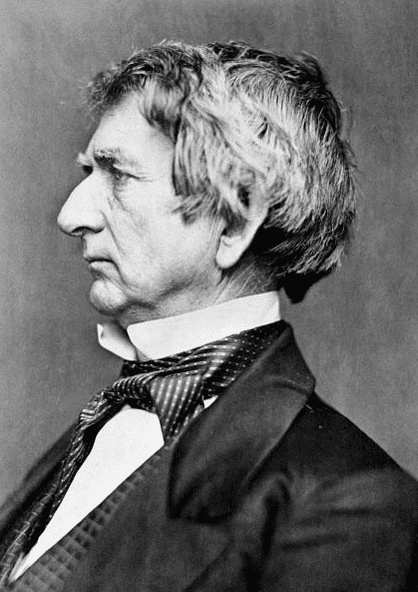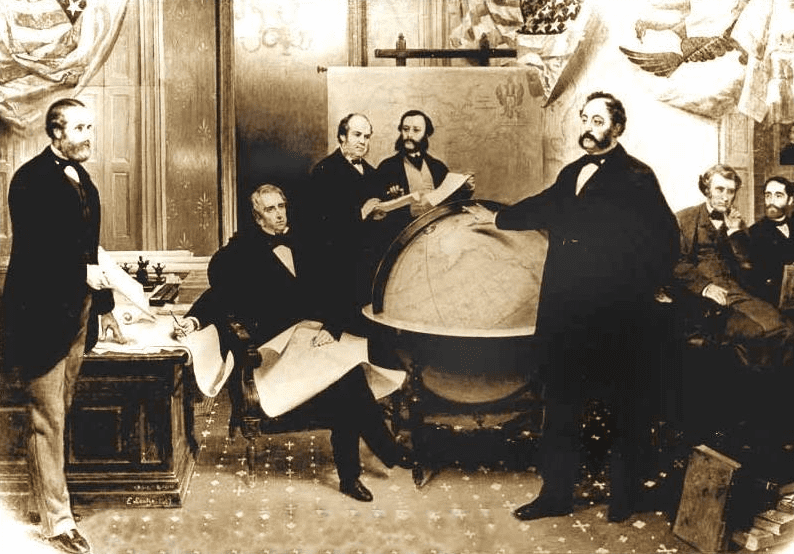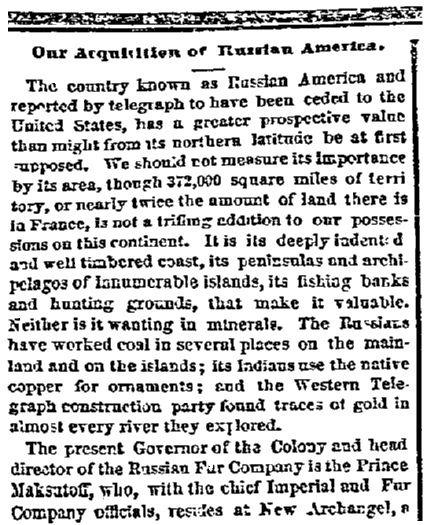Just two years after the Civil War ended, while the nation was busy rebuilding itself, Secretary of State William Henry Seward surprised many by negotiating with Russia to purchase Alaska for $7.2 million, amounting to the ludicrously low price of about two cents per acre. Even so, critics blasted the purchase as “Seward’s Folly,” wasting money on a barren, remote land of ice and snow.

The Alaska Treaty of Cessation was signed on 30 March 1867, and ratified by the U.S. Senate on April 9. Russia transferred Alaska to the U.S. on 18 October 1867 in a formal ceremony in Sitka.

No one was laughing on 3 January 1959 when Alaska was admitted as the 49th state into the Union. By then, Alaskan gold, salmon and timber had generated billions of dollars, and oil exploration was promising a robust petroleum industry. Equally significant in 1959, with the Cold War a constant presence in American strategic thinking, was the proximity to Soviet soil and the northern line of defense Alaska provided.
Despite the ridicule of his many critics at that time, not everyone was laughing in 1867 when Seward completed his negotiations with Russia. Some observers recognized the many business opportunities in Alaska, as made clear in this article from an 1867 California newspaper.

Here is a transcript of this article:
Our Acquisition of Russian America
The country known as Russian America and reported by telegraph to have been ceded to the United States, has a greater prospective value than might from its northern latitude be at first supposed. We should not measure its importance by its area, though 372,000 [correction: 586,412 – ed.] square miles of territory, or nearly twice the amount of land there is in France, is not a trifling addition to our possessions on this continent. It is its deeply indented and well timbered coast, its peninsulas and archipelagos of innumerable islands, its fishing banks and hunting grounds, that make it valuable. Neither is it wanting in minerals. The Russians have worked coal in several places on the mainland and on the islands; its Indians use the native copper for ornaments; and the Western Telegraph construction party found traces of gold in almost every river they explored.
The present Governor of the Colony and head director of the Russian Fur Company is the Prince Maksutoff, who, with the chief Imperial and Fur Company officials, resides at New Archangel, a town on the Island of Sitka, and opposite the western part of British Columbia. Here there is a population of 1,000 whites and half-breeds, and at this point the furs are gathered from the different trading stations, and supplies are stored for distribution. Vessels trade between Sitka and St. Michaels, a fort on a small island in Norton Sound and near to Behring Straits.
The main land east and south of St. Michael’s is a fine open country, watered by numerous rivers, some of which are of considerable size. One of them, the Kvichpak, has four mouths, and is available for vessels drawing ten or twelve feet for many hundred miles. At 600 miles above its mouth it is more than a mile wide, and was navigated last year by a stern-wheel steamer belonging to the Telegraph Company’s fleet. Scattered through this portion of the country the Russian Fur Company have five or six minor trading posts. One of their most important places, however, is the island of St. Paul in the Behring Sea. Its great value is derived from the number of seals and sea otters which frequent it and the adjacent rocks, and by hunting which the Indians and half-breeds live.
One of the first advantages that San Francisco will gain is the sole right to the cod-fisheries on the south of the peninsula of Alaska and the Aleutian Islands. These banks, which are little more than half the distance from San Francisco to the Ochotsk Sea, have hitherto been little frequented, but are likely to be more thought of now they have become American territory. Kodiak, the island from which all the ice used in San Francisco is brought, is the largest of the Alaska group. Nearer the extremity of the peninsula is Choumagan Island, a place where Russian steamers, passing from Sitka to Petropaulowski, in Siberia, and the Western Union Company’s vessels have been accustomed to take in supplies of coal. All these islands have good harbors on the southern sides and every convenience for drying fish. Another advantage is that the cession must make San Francisco the headquarters of the Pacific fur trade. All the Indian population of this new territory and most of those in British Columbia live on the coast or on the banks of the rivers, and beyond fishing have no means of subsistence except such as they procure from the Fur Companies’ posts in exchange for sea otter, seal, beaver, mink, ermine, fox and other skins. The possession of the soil will be followed by the imposition of custom dues, and the supplies that have hitherto been brought from Hamburg or purchased in Victoria must then pay duty, and may be more economically purchased here. The Russian Fur Company are pushing their business chiefly in Siberia, and though they keep up the posts we have named, and secured others, have not for some years taken much interest in that part of their boundary lying between British Columbia and the Pacific. A few years ago the Hudson Bay Company leased from the Russian Company their right of trading on that strip of coast. And the largest portion of the English Company’s profits on fur trading have been made on territory that is now United States property, and for the future they will have to comply with United States customs regulations. The direct trade between Vancouver Island and Sitka has for the last 2 or 3 years reached about $50,000 annually, and during 1866 the amount was swelled by some large items for machinery and repairs to shipping. This extension of our flag to the northernmost point of the continent promises to benefit San Francisco considerably while it will deal a fatal blow to British interests in the North Pacific by destroying almost the sole remaining export trade Vancouver Island has. It will cut off so much of the profits of the Hudson Bay Company that it will hardly be worth the Company’s while to maintain their present establishment, unless they are inclined to make trading with the Caribco miners their chief business.
Probably one of the Aleutian Islands will be selected as a permanent military and naval station, for the protecting of our whaling and other fishing interests, and where our vessels can put in for repairs and supplies. It is understood that some preparations were made for this purpose during the negotiations, and it is presumed that as soon as the treaty is ratified, active measures will be taken to carry out the plan. New Archangel or Sitka Island will also, it is understood, be made a military and naval station for the protection of our fisheries in the Northern Sea, Prince William’s Sound and Cook’s Inlet.
It certainly seems that Russia is stripping herself for a fight, by getting rid of territory that would be likely to fall into the power of England or France, in case of a war with either or both of those States. She has virtually said to the United States, I will give you my American possessions for a nominal sum, provided you will defend them against my enemies, the Western Powers, while I fight them in the East. This, taken in connection with the Greek and Turkish imbroglios, is a most significant measure, and many will regard it as indicative of another war on the Eastern question.
Note: An online collection of newspapers, such as GenealogyBank’s Historical Newspaper Archives, is not only a great way to learn about the lives of your ancestors – the old newspaper articles also help you understand American history and the times your ancestors lived in, and the news they talked about and read in their local papers. Did any of your ancestors travel to or live in Alaska? Please share your stories with us in the comments section.
